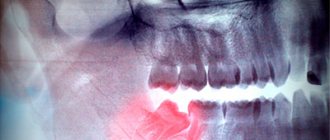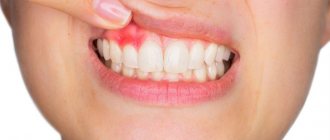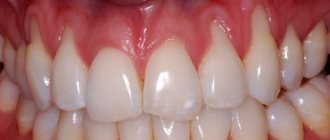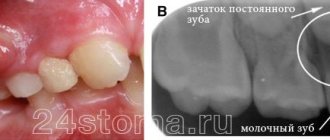01.12.2019
Single crowns and bridges are permanent prostheses that can hide significant deficiencies of natural but damaged teeth or replace their crown part. During operation, such products have their own characteristics, one of which is difficulty in washing them and surrounding tissues.
To facilitate hygienic care, the dentist makes a small temporary gap between the gum tissue and the marginal line of the crown during the prosthetic process. The prosthetic indentation is called flushing. Due to various factors, the tolerance for liquid may increase, food particles may get into it, which over time leads to complications and the development of complex diseases. About 20% of patients suffer from problems with the flushing space. What are the causes of such pathologies and how to eliminate them, we will consider in this article.
REASONS FOR THE APPEARANCE
Most often, the space between the crown and gum increases due to medical errors during prosthetics. When the prosthesis is pressed strongly against the surface of the tooth or if it is not firmly placed on the base, an unacceptable gap size appears between the gum and the masking product.
However, in some cases the problem does not arise through the fault of the doctor.
Unpleasant phenomena develop against the background of pathological processes in the patient’s oral cavity:
- Inflammation of the interdental papillae, gums and degenerative processes in the periodontal tissues. Such problems with oral health often develop when the body's protective properties are weakened, which is accompanied by allergies and inflammatory reactions to poor hygiene.
- Loss of tightness of the elements that firmly fix the removable device in the oral cavity.
- Splitting of the bridge in the area of contact with artificial crowns. If the denture has been damaged even slightly, it will inevitably change its correct position and have a detrimental effect on the tissues surrounding the tooth.
- Disintegration of a single crown. This happens if the device was installed incorrectly or when saliva gets under the crown.
- Poor oral hygiene causes inflammation of the gum tissue with swelling, which will change the size of the rinsing gap.
- Poor quality of preparation before prosthetics. Insufficient sanitation of the oral cavity, poor strength of hard and soft tissues lead to gradual destruction of the protective layer of teeth. The orthopedic device begins to settle, thereby lifting the gum above the crown.
- Periodontal disease and periodontitis. Such diseases lead to changes in the position of individual teeth, which, by their displacement, increase the size of the washing gap.
- The patient's attempts to clean the interdental space with toothpicks or other sharp objects. After such procedures, the gap between the denture and the tooth increases, food begins to get stuck and becomes a provocateur for the proliferation of pathogenic microorganisms.
- The fixing composite composition has become unusable. After the expiration of the dental cement with which the fixation was made, the crown moves away from the tooth, creating a space for food to enter. It gradually rots and thereby causes an inflammatory process.
- Excessive chewing loads on the structure. Strong pressure on the crown leads to its breakage. It happens that a tooth breaks along with the product, and it is almost impossible to save it after that.
Remember! The fit of the structure to the teeth should be optimal. That is, too tight contact or insufficient fit is unacceptable.
In the first case, such an installation can result in trauma to the tissues and mucous membranes of the mouth, in the second, the fixation of the structure is weakened, which threatens negative changes in pronunciation and difficulties in the process of eating.
Such defects very quickly disable the prosthesis without the possibility of its restoration and bringing it into working condition.
During the period of adaptation after installation of the orthopedic structure, the special gap between it and the gum should normally increase slightly. However, after 7 days of recovery, the gap width should become smaller if the patient has cared for the area properly.
Dentist's fault and inflammatory processes in the oral cavity
One of the most common reasons for a large gap to appear is a medical error. This can happen due to the crown fitting too tightly to the soft tissue or, conversely, if the installation of the structure is insufficiently strong.
However, a large gap does not always appear due to the doctor’s fault. Sometimes the reason for this is the presence of serious inflammatory processes, for example on the interdental papillae, in the gums or in the tissues that surround the tooth itself. Quite often, complications appear against the background of a general deterioration in a person’s health and when the functioning of his immune system is disrupted.
Other reasons: insufficient oral hygiene, as well as allergic reactions to the drugs and materials used in the work of the master. If the tightness is broken and the strength of the crown fixation decreases, visible gaps may also form over time. In any case, the situation requires immediate intervention by qualified medical personnel.
FIRST SIGNS
The optimal flushing gap (norm of a fraction of a millimeter), when installed correctly, ensures:
- proper fixation of the device;
- high-quality hygiene;
- protection against manifestations of pathologies of periodontal tissues;
- long-term operation of the product.
Normally, this temporary effect should not cause any complications.
You should be concerned after installing a prosthesis in the following cases:
- discomfort appears and pain occurs in certain areas of the oral cavity;
- the structure has changed its position in the mouth and this is noticeable;
- increased sensitivity of tissues and teeth to irritating foods (cold, hot, spicy, salty) and temperature changes;
- bothered by itching and burning;
- manifestations of a lisp develop;
- a whistle is heard from the mouth during a conversation;
- The general condition of the oral cavity is only getting worse every day.
The listed undesirable manifestations can be observed at the site of localization of the orthopedic product or beyond.
If the first symptoms appear, it is important to immediately seek help from a specialist.
If you have any mistrust in your dentist or orthopedist, you can get alternative advice and assistance at another medical institution.
The color of the crown matches the adjacent teeth
The color of any crown, with the exception of a metal one, should match the color of the neighboring teeth. It is also important to observe a natural transition, when the tooth at the neck is slightly yellowish, and closer to the cutting edge it turns white and becomes transparent.
If the new crown causes you discomfort, you feel it like a foreign body, then we recommend that you immediately contact your dentist. It may have been installed incorrectly and requires correction. You should also come for an appointment if, after installing a metal-ceramic crown, you feel a metallic taste in your mouth.
POSSIBLE COMPLICATIONS
If you ignore the problems that have arisen and do not visit a doctor in time for an examination, as well as to identify the causes of the gap, the patient risks encountering serious troubles and complications, namely:
- development of complex inflammation in periodontal tissues;
- sudden dismantling of the entire structure;
- destructive diseases of the units located under the crowns;
- allergy attacks to prosthetic material;
- complete breakdown of the device in the area adjacent to the crowns;
- the appearance of excessive galvanic currents in the oral cavity;
- increase in electrical conductivity of saliva;
- the appearance of signs of inflammation of the mucous membrane;
- relapses of carious processes;
- development of general symptoms of unwellness of the body;
- erosive and ulcerative lesions of the mucous membrane;
- atrophy of the tissues holding the tooth in the alveolus.
Take into account! If, after installing a crown, you are constantly bothered by painful sensations in the mouth for more than 7 days, the crown periodically moves, senesthopathy, burning, tingling in a certain area appears, the sensitivity of the teeth to irritating foods increases, you cannot do without medical help.
Moreover, the listed manifestations can be localized not only in the area of the installed device.
Another important danger that can arise after prosthetics is the penetration of the prosthesis into the digestive system after unexpected release.
Despite the fact that such products are made from non-toxic raw materials, the risk of damage to internal organs remains. Let's consider the most serious consequences, which, although rare, occur in medical practice:
- perforation of the walls of the digestive tract;
- trauma to the stomach or intestines with subsequent bleeding;
- intestinal obstruction if the swallowed product has formed an obstruction with its body.
In such cases, it is very important to immediately go to the hospital or call an ambulance. An acute clinical picture of this nature requires examination by a surgeon, gastroenterologist, or emergency transportation of the patient to the nearest emergency room.
Prosthetics with metal-ceramic crowns
These crowns are the most durable and most aesthetic material used in prosthetics. Crowns completely imitate the appearance of your teeth and restore their functions. Due to the fact that our clinic has its own laboratory, we can achieve excellent aesthetic results, and, importantly, we reduce the time required for prosthetics (on average, a metal-ceramic prosthesis for 3 units is made in 5 days). During the fabrication of the prosthesis, you use a temporary plastic prosthesis. Much depends on the mass used in the laboratory. Here we use the German Vita Omega mass, which we are 100% confident in.
ELIMINATION TACTICS
Any specialist in the dental niche, providing his services, is obliged to create an ideal fit of the orthopedic structure on the bed. That is, even if minor changes occur in the distance between the device and the working surface, the gap should remain at the optimal permissible width.
It is also important to take into account the fact that any foreign body in contact with organs and tissues of the body can initially cause discomfort, which normally can last no more than one week.
If, after this period, the body continues to signal with unpleasant symptoms, then this is a good reason to seek medical help.
If the gap between the crown and the gum has widened beyond normal limits, doctors solve the problem in the following ways:
- Local anti-inflammatory and antiseptic treatment is carried out by treating damaged areas with gels, ointments and other effective means. In this case, the structure itself is first removed from the oral cavity.
- The dental device is adjusted and adjustments are made to its parameters. If the product is unsuitable, the doctor decides to make a new design. Before this, it is important to obtain orthopantomogram data.
- The orthopedist can grind and adjust the prosthesis right in his office when the patient contacts him. All actions are performed depending on the clinical picture.
If the problem lies in the loosening of problem units, they are strengthened. After this, the prosthetics are repeated.
The rarest occurrence is the peeling of the structure when it comes to a bridge. The trouble is accompanied by a change in the position of the supporting units, which results in the need for re-prosthetics.
To avoid this, you need to go to the clinic where the installation procedure was carried out on the same day and eliminate any existing defects and defects.
Attention! Installation of crowns is permanent prosthetics. Therefore, it is not possible to simply remove the device and rinse it under clean running water or clean it using special products and return it to its place.
If the gap has increased, it means that it is urgently necessary to take measures to normalize its size.
Mechanical enlargement of the gap has one solution - reinstallation of the prosthesis. The specialist dismantles the system for correction or completely replaces it, after carrying out health measures and following a competent algorithm of actions during installation.
The shape of the crown matches the shape of the tooth
When making a crown, it is necessary to reproduce the anatomical shape of the tooth as accurately as possible. To do this, the technician draws the chewing tubercles, creates contact points and clearly draws the equator.
- The tubercles and pits on our teeth perform different functions, and each element has its own function. Some parts are designed for grinding food, others fix the correct bite or distribute the chewing load. The tubercles also ensure proper closure of the crown with the antagonist tooth located opposite it. If the closure is not tight enough, both teeth will move to the side, trying to take the correct position. Incorrect placement of the tubercles will be indicated by discomfort from the crown 2-3 weeks after installation. The doctor checks this point using a piece of special paper on which traces remain. This is also why temporary crowns are used, a kind of test drive.
- Equator. We are talking about a thickening, thanks to which food does not fall on the gums, but slides inside the oral cavity, as if down a slide. If the equator on the new crown is flat, then food particles will fall into the periodontal sulcus, which will lead to inflammation and discomfort. Contact point. This refers to the point at which adjacent teeth meet. It must be present, otherwise an interdental gap will form into which pieces of food will get clogged. Inflammation of the corresponding area of the gum may also appear. To test, take dental floss and pull it between your teeth. If you hear a click, there is a contact point.
PREVENTION MEASURES
To prevent problems with the crown from occurring, the patient must strictly follow the medical recommendations that are communicated to him immediately after the prosthetic procedure:
- perform high-quality hygienic care for the product, organs and tissues of the oral cavity at least 2 times a day;
- Use herbal rinses and dental hygiene devices for additional cleansing 3 times a week;
- periodically visit the attending physician for a preventive examination, monitoring the condition of the structure, and its professional cleansing of food particles;
- use a special dental brush to remove the smallest food residues after each meal;
- use wound-healing pastes for prevention if the slightest discomfort occurs (especially during the period of adaptation);
- purchase an adhesive base to cover the space between the crown and gum tissue (only on the advice of a doctor);
- use a special mouth guard with a cleaning agent, which is placed in the area of the prosthesis to lighten its shade and provide antiseptic treatment;
- limit or completely eliminate coarse salt, poppy seeds, shortcrust pastries, crackers from the diet;
- come to the clinic in a timely manner to make adjustments to the parameters of the orthopedic product in order to prevent the risk of device displacement and widening of the irrigation gap.
Forbidden:
- use a stiff toothbrush;
- apply floss around the neck of the tooth with a crown installed (an irrigator is recommended to clean such places);
- use hard and sharp auxiliary tools (match, needle, sliver, etc.).
Preventive measures must be carried out conscientiously by the patient. Not only the health of the oral cavity and the body as a whole, but also the lifespan of the crown will depend on the quality of care.
Category: Tooth extraction Published by Mister stomatolog
A tooth deteriorates under a crown: truth or myth?
Any type of prosthetics is a complex dental procedure, after which complications may arise. However, if you lose one or even several teeth, installing implants is the most correct treatment option. If after prosthetics the tooth under the crown begins to hurt, this may be either normal or a deviation from the norm. In both cases, professional advice is required.
Where is the problem?
It is not uncommon for patients to deliberately refuse prosthetics. This is due to the unsuccessful experiences of themselves, relatives or friends. It should be understood that if a tooth is lost, such an intervention is correct for the body. It allows you to restore the functionality of the tooth. If all procedures are performed correctly, the patient strictly follows the rules of hygiene, dental crowns will last him a long time. But this process is associated with a number of errors and inaccuracies, which can subsequently lead to damage to the tooth and replacement of the implant.
There are four important aspects to this problem:
- errors at the preparation stage;
- poor dental work;
- low-quality materials;
- incorrect hygienic care.
Clinical symptoms
The very first signs of problems with the dental crown will be pain, bleeding, and possibly purulent discharge. The patient may also be concerned about:
- decreased tooth fixation - the crown is loose and does not fit tightly to the gum;
- redness, swelling of the gums and adjacent tissues;
- increased sensitivity;
- unpleasant putrid odor from the mouth;
- itching, irritation;
- the appearance of excess plaque.
Photo 1. Inflammation of the gums under the crown
| Cause | Symptom |
| Pulp inflammation | Sharp cutting pain that occurs in the evening or at night. |
| Caries | Increased sensitivity to hot and cold foods. An unpleasant odor appears from the mouth. Pain occurs when chewing. |
| Periodontitis | Unpleasant sensations in the neck of the tooth. Signs of inflammation are observed: swelling and redness. |
| Incorrect crown installation | The crown rubs, puts pressure on soft tissues, does not fit firmly to the gums and wobbles. The pain is dull, aching, and does not go away for a long time. |
Table 1. – Comparative characteristics of the localization of pain and the causes of its occurrence
There was pain
The appearance of pain signals the patient about the development of inflammation in the oral cavity. When installing the crown itself, tissues are injured. Usually, such microtraumas heal quickly and pain does not appear at all. But if a person initially had a decrease in immunity, then microorganisms actively multiply and cause inflammation.
Pain can also develop due to an allergic reaction to the filling material.
Attention: before installing an implant, you must consult a dentist and an allergist about the possible development of allergic reactions to the materials from which dental crowns are made and impressions are made.
Pain also appears in case of exacerbation of hidden pathology, since trauma to tooth tissue during the procedure and a change in load distribution induces the process of inflammation. As a result, pain appears.
If there is pain under the crown, you should immediately contact your dentist. He will prescribe the correct treatment, which can be either therapeutic or surgical. In some cases it will be necessary to remove the crown, while in others it will not be necessary.
It is also possible to make a hole, clean and re-seal the canals. The crown is then covered with dental material, and its function is considered restored.
It is possible to perform surgery to remove the root tip. This procedure is usually performed in the presence of a purulent sac. The poorly sealed apex is removed, the dentist reaches the purulent sac, cuts the gum tissue, removes it, treats it with an aseptic agent and the edges of the gum are sutured.
Photo 2. Removing the root tip
And the last case of pathology, when it is necessary to remove the crown and refill the canals, is an advanced and deep inflammatory process. Although in serious situations, dentists usually remove the crown and tooth, after which a post with a dental crown is installed.
Causes of pain under the crown
Only a dentist can determine the exact cause of pain under the crown. However, the most common ones are:
- the root canals are not filled correctly (an inflammatory focus or even a cyst forms at the root of the tooth);
- poor obturation of root canals (can lead to various complications:
- Immediate: Longitudinal root fracture, post-filling pain, exacerbation of a chronic inflammatory process;
- Long-term consequences: the emergence of a focus of chronic odontogenic infection, the focus of infection persists or progresses, change in the color of the tooth crown;
- perforation of the walls of the root canal (may appear as a result of caries or after mechanical trauma to the tooth; the most common reason is bending of the canals, which significantly complicates tooth treatment);
- breakage of an instrument in the lumen of the root canal (a dangerous situation for the dentist and the patient, the outcome of which depends on many factors, including the material of the crown, the location and size of the instrument, and the anatomical features of the root canal).
Less commonly, they can also cause pain:
- rubbing gums;
- periodontitis;
- insufficient tooth depulpation before prosthetics;
- root damage from incomplete preliminary preparation;
- installation of an implant on diseased teeth;
- root canal infection;
- excessive filling of the root canal with filling material;
- wear of the prosthesis.
Attention: if pain appears immediately after installation of the prosthesis or during the first week, this indicates improper preparation of the tooth, and the patient should immediately contact the dental clinic.
How to get rid of pain
Every patient should understand that the use of painkillers and other options for pain relief are just symptomatic treatment that will not solve the problem. At the first manifestation of pain, you should immediately consult a doctor. Ways to relieve toothache include:
- Painkillers, for example, Diclofenac, Ketorolac, Nimesil, Tempalgin, Ibuprofen (dosage forms - tablets, gel).
- Applying a cold salt compress to the damaged gum.
- Mouth rinse. To do this, use a decoction of herbs such as sage, calendula or chamomile, as well as a soda solution.
- Rinse with baking soda and iodine. In addition to eliminating pain, such rinsing will relieve itching and irritation.
- Compress with valerian and camphor. This folk remedy will help in the fight against pathogenic microorganisms and soothe inflamed gums.
Attention: do not abuse painkillers. They should be carefully alternated with rinses. It is not recommended to take pills before visiting a doctor to avoid distorting the symptomatic picture.
Prevention
To prevent complications after installing a crown, it is important to regularly visit the dentist for a preventive examination (1-2 times a year at least; if discomfort occurs, immediately seek advice). You should strictly observe the rules of oral hygiene every day. Cleaning products must match the material from which the prosthesis is made. Dentists recommend using additional elements for cleaning teeth: special brushes, brushes, dental floss, and irrigator.
You must strictly follow all recommendations of your treating dentist. You should give up bad habits such as alcohol and smoking, because they have a bad effect on the mucous membranes and induce the development of the inflammatory process. If the patient cannot completely quit smoking, then the harmful effects of nicotine and other substances should be minimized. To do this, after smoking a cigarette, you should immediately brush your teeth and rinse your mouth with a special product.
How to care for a crown
General methods of crown care are given in the table.
| Toothbrush | Mostly medium hard. Cleansing movements are directed from the gums to the cutting edge of the tooth. Use at least 2 times a day (more if necessary, but the risk of injury to the prosthesis may increase). The toothbrush must be replaced every 3 months. Attention: to clean hard-to-reach places, you can purchase a mono-tuft brush). |
| Toothpaste | Preference should be given to medicinal pastes that strengthen the gums and reduce bleeding. They usually contain herbs. It is forbidden to use pastes containing abrasive materials, as they damage the crown. |
| Dental floss | It is worth choosing “super floss”, designed specifically for dentures. They clean the surface of the prosthesis from the gum side as well as possible. Caution: Regular floss is too harsh for a dental crown and can damage it. |
| Irrigator | A professional product that uses a jet of water under pressure to remove plaque, pathogenic microorganisms and food debris. The nose of the irrigator should be directed towards the area between the denture and the gum. The pressure of the supplied water should initially be minimal, and then it should be gradually increased to average values. Attention: in addition to the high cleaning coefficient, the irrigator massages the gum tissue, thereby improving blood circulation. |
| Rinse aid | Selected in accordance with the dentist's recommendations. It should have antibacterial properties and should not spoil the crown materials. |
Table 2. – Cleansers recommended for use when installing dentures.
Some care features determined by the material of the manufactured crown are given below.
Crowns on implants
Once the structure has completely fused with the tissue, you can return to a full life. There will be no special dietary restrictions here, except for a ban on very hard foods, cold and hot. Chew your food thoroughly and slowly, cutting hard foods into smaller pieces.
Metal-ceramic crowns and bridges
Metal is the most durable material, but still you should not use improvised means to clean the implant, as they can damage the coating of the crown and the enamel of other teeth.
Attention: Under no circumstances should you try to open nuts, bottles or other objects with your teeth!
Metal-free zirconium crowns and bridges
Caring for prostheses made from such materials should be more thorough and gentle. It is recommended to use a special mini-brush, which carefully and thoroughly cleans hard-to-reach places
Restoration of the coronal part of the tooth using modern light-curing composites
Tooth restoration is a procedure that is performed for cosmetic tooth defects. It allows you to improve a tooth damaged by caries, restore broken ones, straighten teeth, and correct color. Composite systems have high ductility and strength, they exactly match the characteristics of the dentition.
The procedure can be carried out in two ways:
- Direct (composite materials are applied directly to the tooth).
Photo 3. Direct tooth restoration
- Indirect (restoration elements are pre-fabricated).
Photo 4. Indirect tooth restoration
With conventional prosthetics, the main goal is to restore the functioning of the tooth, and with their restoration - the aesthetic side. To add shine and natural color, dentists use photocomposites, which are applied to the teeth in layers using adhesives.
When to see a doctor
The appearance of pain after installation of a prosthesis may be a normal condition that will soon go away. Dentists recommend that patients listen to their feelings: if the condition is unsatisfactory, then a trip to the doctor will definitely not be superfluous. You should not endure and hope that the pain will go away, because the process may worsen, and then the doctor will have no choice but to remove the tooth and install a new prosthesis.
Features of prosthetics
Even a minor foreign body in the oral cavity causes some discomfort, not to mention a full-fledged orthopedic product. The arrangement of teeth has certain characteristics.
So, about 90% of all tissues that hold the tooth in the socket have an oblique direction. It goes from the walls of the alveolar process to the root system at a certain angle.
Thus, it turns out that the tooth is, as it were, suspended on these tissues. This provides it with microexcursion and allows the enamel to withstand excessive loads. Orthopedists must take this point into account when performing various types of prosthetics.
Placement of a separate artificial crown
It is mainly used when it is impossible to restore hard tissues with filling materials, for example in the case of severe destruction of enamel and dentin. To place an artificial crown, the dentist removes a certain layer of hard tissue to the thickness of the material that will cover the tooth.
Prosthetics will take a certain amount of time. Since our body is built in a specific way, the ground tooth begins to seek contact with the antagonist.
It is as if he is tightening his height to the thickness that the doctor removed. Therefore, after fixing an artificial crown, many note certain inconveniences.
If this is associated only with a specific reaction of the periodontal ligaments, then the negative sensations disappear within 3 days. In this case, a gap may appear between the tooth and gum.
In principle, this is a natural formation called a gingival beard. But when turning the enamel, it becomes much larger.
When installing an artificial crown, its edge must be partially immersed in the anatomical formation. If the tooth appears to have “raised”, the root groove will be more pronounced.
Formation of a gap between the crown and gums in the upper jaw
At the same time, the doctor tries to avoid strong pressure on the periodontal tissue from the edge of the orthopedic structure. In this case, trophic stagnation may occur, causing diseases such as localized gingivitis and periodontitis. Therefore, the gap located between the tooth and the gum cannot be completely filled with an artificial product.
Placement of a bridge
This is a rather labor-intensive procedure that requires the manufacture of a complex structure consisting of several elements. In addition, the bridge must be placed in the oral cavity according to certain requirements.
For example, its peculiarity is that there must be a flushing space under the prosthetic bed. This is a small gap up to 3 millimeters wide.
Very often, patients complain of food retention, specifically in the area of this formation. Indeed, many people have this problem, but if pieces of food get stuck in this place in large quantities, then they speak of poor-quality manufacturing of the prosthesis, or its incorrect fit, or, much worse, the development of certain complications. You can learn how bridges are installed from the video in this article.











